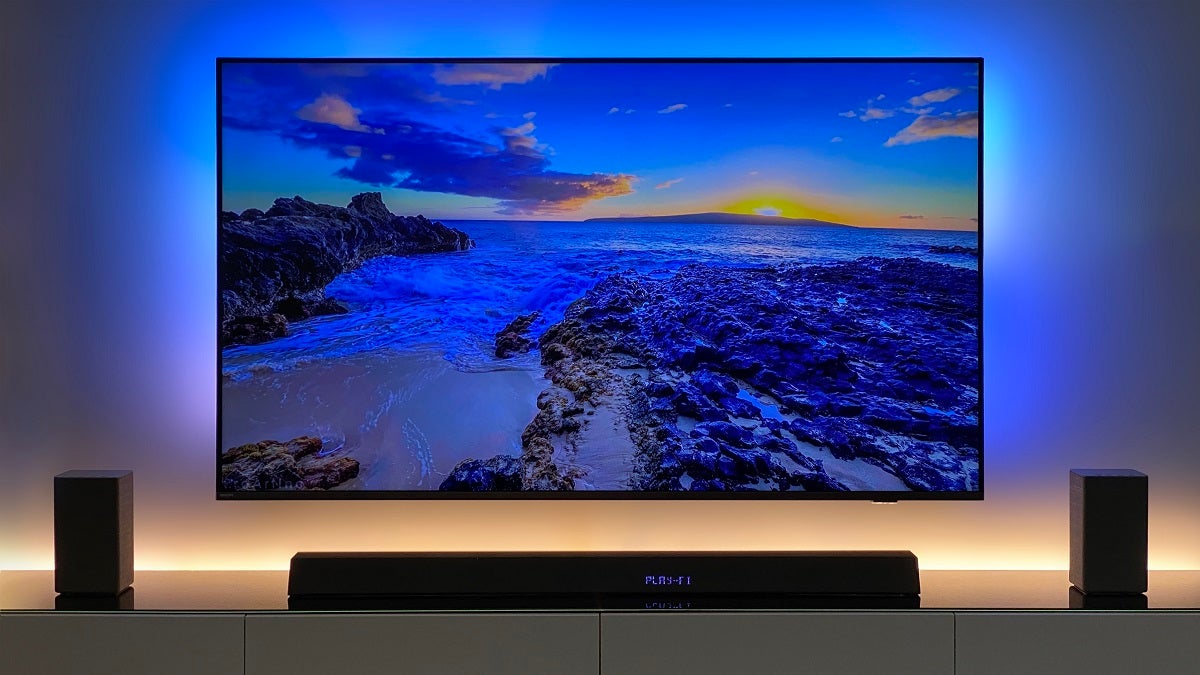Home>Production & Technology>Sound Bar>What Is Difference Between 2.1 And 2.2 Sound Bar


Sound Bar
What Is Difference Between 2.1 And 2.2 Sound Bar
Modified: February 18, 2024
Looking to upgrade your sound experience? Discover the key differences between 2.1 and 2.2 sound bars and choose the perfect one for your audio needs.
(Many of the links in this article redirect to a specific reviewed product. Your purchase of these products through affiliate links helps to generate commission for AudioLover.com, at no extra cost. Learn more)
Table of Contents
Introduction
Welcome to the world of sound bars! Sound bars are a popular audio solution for enhancing the sound quality of your TV or home theater system. With their sleek design and immersive audio experience, sound bars have become a must-have accessory for any home entertainment setup.
In this article, we will explore the differences between two common types of sound bars: the 2.1 and the 2.2 sound bar. Whether you’re a music enthusiast, a movie lover, or a gaming aficionado, understanding these differences will help you make an informed decision when choosing the right sound bar for your needs.
Before we delve into the specifics of each sound bar, let’s take a moment to understand the basic concept of a sound bar. Unlike traditional bulky speakers and complex audio setups, sound bars offer a streamlined and compact alternative. They consist of a single unit that houses multiple speakers and often a built-in amplifier. This all-in-one design allows sound bars to deliver high-quality audio with minimal setup and clutter.
Now, let’s turn our attention to the 2.1 sound bar. The “2.1” refers to the number of channels, with “2” representing the two main speakers and the “1” indicating the presence of a dedicated subwoofer. The addition of a subwoofer enhances the low-frequency sound reproduction, resulting in richer and more impactful bass. This makes the 2.1 sound bar ideal for creating a more immersive audio experience, whether you’re watching movies, playing video games, or listening to music.
The 2.2 sound bar takes things a step further by featuring two subwoofers instead of just one. This additional subwoofer provides even deeper bass response and greater clarity in the lower frequency range. With the 2.2 sound bar, you can expect to experience a more pronounced and dynamic audio performance, allowing you to truly feel the rumble of explosions or the thump of bass-heavy music.
Overview of Sound Bars
Before we dive into the specifics of the 2.1 and 2.2 sound bars, let’s first understand the benefits and features that make them a popular choice among audio enthusiasts.
Sound bars are designed to enhance the audio experience of your TV or home theater system. They come in a variety of shapes and sizes, but their main purpose is to deliver high-quality sound without the need for complex wiring or multiple speakers.
One of the key advantages of sound bars is their space-saving design. Unlike traditional speaker setups that require multiple speakers scattered around the room, sound bars come in a sleek, compact form factor that can be easily placed below or above your television. This minimalist design not only saves space but also adds a touch of elegance to your home entertainment setup.
Additionally, sound bars offer easy installation and setup. Most sound bars can be connected to your TV or audio source using a single cable, eliminating the need for a mess of tangled wires. Some models even come with wireless connectivity options, allowing you to stream music from your smartphone or tablet directly to the sound bar.
Another advantage of sound bars is their ability to simulate surround sound. While true surround sound systems typically require multiple speakers placed strategically around the room, sound bars utilize advanced audio technologies to create a convincing surround sound experience from a single sound bar. This immersive audio experience enhances your movie-watching or gaming sessions, making you feel like you’re right in the middle of the action.
Furthermore, many sound bars come with built-in equalizers and audio presets, allowing you to customize the sound according to your preferences. Whether you prefer deep bass, clear vocals, or a balanced sound profile, you can adjust the settings to suit your taste.
Overall, sound bars provide a convenient and effective way to upgrade your audio system. They offer high-quality sound, easy installation, space-saving design, and the ability to create an immersive audio experience. Now, let’s take a closer look at the specific features and differences between the 2.1 and 2.2 sound bars.
Explanation of 2.1 Sound Bar
The 2.1 sound bar is a popular choice for those looking to enhance their audio experience with a dedicated subwoofer. The “2.1” designation refers to the number of channels the sound bar has – two main speakers and one subwoofer.
The main speakers in a 2.1 sound bar are responsible for producing the higher and mid-range frequencies, delivering clear vocals, dialogue, and instrumental details. They provide a wider soundstage, making it feel like the sound is coming from different directions, creating a more immersive listening experience.
However, what sets the 2.1 sound bar apart is the addition of a dedicated subwoofer. The subwoofer is responsible for handling the low-frequency sounds, such as deep bass notes and rumbling explosions. By incorporating a subwoofer into the setup, the 2.1 sound bar delivers a more robust and impactful bass response.
The subwoofer in a 2.1 sound bar can be either wired or wireless, depending on the model. Wired subwoofers are connected to the main sound bar via a cable, while wireless subwoofers connect to the sound bar wirelessly, reducing cable clutter and allowing for more flexible placement options.
The addition of a subwoofer in the 2.1 sound bar configuration allows for a more balanced and full-bodied audio experience. It enhances the audio quality, particularly in scenes that involve heavy bass, such as action movies or music with deep basslines.
Whether you’re watching a thrilling movie, playing immersive video games, or simply enjoying your favorite music, the 2.1 sound bar offers a significant upgrade to your audio setup. The combination of the main speakers and the dedicated subwoofer ensures that you can enjoy a wide range of sound frequencies with clarity, precision, and powerful bass.
Now that we understand the basics of the 2.1 sound bar, let’s move on to explore the 2.2 sound bar and see how it differs from its counterpart.
Explanation of 2.2 Sound Bar
The 2.2 sound bar takes the audio experience to the next level by featuring not one, but two dedicated subwoofers. Similar to the 2.1 sound bar, the “2.2” designation refers to the number of channels – two main speakers and two subwoofers.
The main speakers of the 2.2 sound bar are responsible for producing the higher and mid-range frequencies, delivering clear and detailed sound reproduction for vocals, instruments, and various audio effects. They provide a wide soundstage, creating an immersive audio experience that enhances your movies, music, and games.
Where the 2.2 sound bar truly shines is with the addition of two subwoofers. These dedicated subwoofers are designed to handle lower frequency ranges, providing a more pronounced and impactful bass response. With two subwoofers, the 2.2 sound bar is capable of delivering even deeper bass notes and rumbling vibrations compared to the 2.1 sound bar.
Having two subwoofers in the 2.2 sound bar configuration offers several advantages. Firstly, it provides improved bass accuracy and clarity, as each subwoofer is specifically tuned to handle specific frequency ranges. This results in a more precise and balanced bass performance, adding depth and richness to your audio experience.
Additionally, the dual subwoofers in the 2.2 sound bar provide enhanced bass distribution throughout the room. With two subwoofers working in tandem, you can experience more consistent bass response, regardless of your seating position. This ensures that everyone in the room can enjoy the full impact of deep bass notes and explosions.
Moreover, adding a second subwoofer helps to minimize distortion and improve overall audio performance. By spreading the workload across two subwoofers, each subwoofer can handle a smaller portion of the bass frequencies, resulting in cleaner and more accurate bass reproduction.
The 2.2 sound bar configuration is particularly well-suited for audio enthusiasts who crave a powerful and immersive listening experience. Whether you’re a movie lover who enjoys action-packed films, a gaming enthusiast who wants to feel every explosion, or a music lover who appreciates deep basslines, the 2.2 sound bar delivers exceptional audio performance that you can truly feel.
Now that we have explored the features and benefits of the 2.2 sound bar, let’s move on to comparing the 2.1 and 2.2 sound bars to help you decide which one is right for you.
Comparison of 2.1 and 2.2 Sound Bar
Now that we have a clear understanding of the 2.1 and 2.2 sound bars, let’s compare these two configurations to help you decide which one suits your audio needs best.
Bass Performance: When it comes to bass performance, the 2.2 sound bar has the advantage with its dual subwoofers. The two subwoofers deliver deeper, more powerful bass and a more immersive low-frequency experience compared to the 2.1 sound bar’s single subwoofer setup.
Sound Quality: Both the 2.1 and 2.2 sound bars offer exceptional sound quality with clear vocals and detailed audio reproduction. However, the dual subwoofers in the 2.2 sound bar configuration provide more accurate and balanced bass response, resulting in a more refined audio performance overall.
Room Size: The room size can also be a determining factor in choosing between the two sound bar configurations. If you have a smaller room, a 2.1 sound bar may be sufficient to fill the space with rich, immersive sound. However, for larger rooms or if you have a preference for deep bass, the 2.2 sound bar with its dual subwoofers will provide a more impactful audio experience that can better fill the room.
Price: Price is another consideration when comparing the 2.1 and 2.2 sound bars. Typically, 2.2 sound bars tend to be pricier due to the added cost of the second subwoofer. If budget is a concern, the 2.1 sound bar may be a more affordable option while still delivering excellent audio performance.
Flexibility: Both the 2.1 and 2.2 sound bars offer flexibility in terms of placement and connectivity. However, the 2.1 sound bar may be more suitable for smaller spaces or if you prefer a more compact setup. On the other hand, the 2.2 sound bar gives you the added flexibility of dual subwoofers, allowing for better bass distribution throughout the room and more customizable audio settings.
Ultimately, the decision between a 2.1 and 2.2 sound bar depends on your personal preferences, budget, and the size of your room. If you’re a bass enthusiast, have a larger room, and value the enhanced audio performance, the 2.2 sound bar may be the ideal choice for you. However, if you’re looking for a more affordable option that still delivers immersive sound, the 2.1 sound bar is a solid choice.
Now that you have the information needed to differentiate between the two sound bar configurations, let’s explore some factors to consider when choosing between the 2.1 and 2.2 sound bars.
Key Differences Between 2.1 and 2.2 Sound Bar
While both the 2.1 and 2.2 sound bars offer an enhanced audio experience, there are key differences that set them apart. Here are the main differentiating factors between these two configurations:
Number of Subwoofers: The most obvious difference between the 2.1 and 2.2 sound bars is the number of subwoofers. The 2.1 sound bar configuration includes a single dedicated subwoofer, while the 2.2 sound bar boasts two dedicated subwoofers. Having two subwoofers in the 2.2 sound bar delivers more impactful and immersive bass performance.
Bass Response: Due to the presence of dual subwoofers, the 2.2 sound bar provides deeper bass response compared to the 2.1 configuration. The addition of the second subwoofer enhances the low-frequency range, allowing for more powerful and nuanced bass reproduction.
Room Coverage: The dual subwoofers in the 2.2 sound bar offer improved bass distribution throughout the room, making it an excellent choice for larger spaces. The additional subwoofer helps ensure consistent and balanced bass response, regardless of where you are seated in the room. On the other hand, the 2.1 sound bar, with its single subwoofer, may be better suited for smaller rooms where a more compact setup is desired.
Audio Precision: With two subwoofers handling the low-frequency range, the 2.2 sound bar configuration delivers more accurate and refined bass performance. The dual subwoofers allow for better control and separation of bass frequencies, resulting in a more precise and detailed audio experience compared to the 2.1 sound bar.
Price: Another key difference is the price point. Generally, 2.2 sound bars tend to be more expensive than their 2.1 counterparts due to the additional subwoofer. If budget is a concern, the 2.1 sound bar may be the more affordable option while still providing excellent audio quality.
Audio Customization: Both the 2.1 and 2.2 sound bars offer audio customization options. However, the 2.2 sound bar configuration may provide more advanced features and settings for fine-tuning the audio experience. With two subwoofers, you can have greater control over bass levels and EQ, allowing for a more tailored sound profile.
Considering these key differences will help you determine which sound bar configuration aligns with your specific audio preferences, room size, and budget. Whether you opt for the 2.1 or 2.2 sound bar, both configurations offer an upgrade over built-in TV speakers, delivering immersive and high-quality sound to enhance your entertainment experience.
Now that you understand the differences between the 2.1 and 2.2 sound bars, let’s explore some factors to consider when making your decision.
Factors to Consider When Choosing Between 2.1 and 2.2 Sound Bar
When deciding between a 2.1 and 2.2 sound bar, there are several factors to consider that can help you make the right choice for your audio needs. Let’s explore these factors:
Room Size: Consider the size of the room where the sound bar will be placed. If you have a smaller room, a 2.1 sound bar may be sufficient to fill the space with immersive sound. However, for larger rooms, the dual subwoofers of the 2.2 sound bar may provide better bass coverage and a more impactful audio experience.
Listening Preferences: Think about your listening preferences and the type of content you enjoy. If you are a fan of action-packed movies or music genres that rely heavily on deep bass, the 2.2 sound bar may be the ideal choice. The dual subwoofers will deliver a more powerful and immersive bass response. On the other hand, if you primarily listen to dialogue-heavy content or prefer a more balanced sound profile, the 2.1 sound bar might be sufficient.
Budget: Consider your budget when deciding between a 2.1 and 2.2 sound bar. The 2.2 configuration with its additional subwoofer is typically more expensive. If you have a limited budget, the 2.1 sound bar can still provide a significant audio upgrade without breaking the bank.
Available Space: Take into account the available space in your home entertainment setup. The 2.2 sound bar configuration requires additional room for the second subwoofer. If space is limited or you prefer a more compact setup, the 2.1 sound bar may be a better fit.
Audio Customization: Consider the level of audio customization you desire. Both the 2.1 and 2.2 sound bars offer customization options such as EQ settings and sound modes. However, the 2.2 sound bar configuration may provide more extensive customization options and fine-tuning controls, allowing you to tailor the audio experience to your preferences more precisely.
Future Upgradability: If you plan to expand your audio setup in the future, consider the potential for upgradability. In some cases, a 2.1 sound bar may offer compatibility with additional wireless speakers to create a surround sound system. This can be a cost-effective way to upgrade your setup over time.
By considering these factors, you can make an informed decision when choosing between a 2.1 and 2.2 sound bar. Evaluating your room size, listening preferences, budget, available space, audio customization options, and future upgradability will help you select the sound bar configuration that best suits your needs and enhances your audio experience.
Now that you have a comprehensive understanding of the factors to consider, let’s conclude our exploration of 2.1 and 2.2 sound bars.
Conclusion
Choosing between a 2.1 and 2.2 sound bar is an important decision that can greatly enhance your audio experience. Both configurations offer significant improvements over built-in TV speakers, delivering immersive sound and a more enjoyable entertainment experience.
The 2.1 sound bar provides a solid audio upgrade with its two main speakers and dedicated subwoofer. It delivers clear vocals, detailed audio reproduction, and impactful bass response. It is a great option for those who want to enhance their audio experience without breaking the bank.
On the other hand, the 2.2 sound bar takes things to the next level with its dual subwoofers. This configuration offers deeper bass response, enhanced bass distribution throughout the room, and more refined audio performance. It is a perfect choice for audio enthusiasts who crave a truly immersive and powerful listening experience.
When deciding between the two configurations, consider factors such as room size, listening preferences, budget, available space, audio customization options, and potential for future upgradability. Understanding your specific needs and preferences will help you make an informed decision that aligns with your requirements and enhances your audio enjoyment.
Regardless of whether you choose a 2.1 or 2.2 sound bar, both configurations offer a significant audio upgrade and provide a convenient and stylish solution for improving your home entertainment setup. With their sleek design, easy installation, and immersive sound quality, sound bars have become a popular choice for enhancing the audio experience of TVs and home theater systems.
Now armed with the knowledge of the key differences and factors to consider, you can confidently choose the right sound bar configuration that will elevate your audio experience and bring your entertainment to life. Sit back, relax, and enjoy your favorite movies, music, and games with rich, immersive sound that fills the room.











